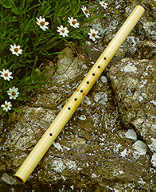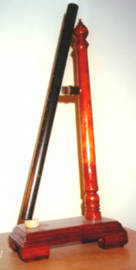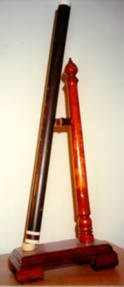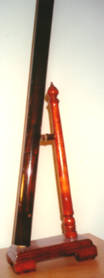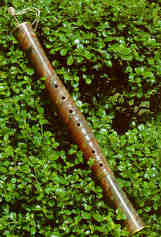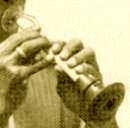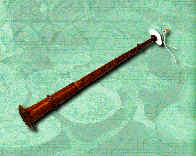|
Khlui The khlui is probably the first wind instrument which the Thai devised themselves, although the shape of the instrument is very similar to that of the mulali of India, which is used to play music in worship of Krishna, one of the Hindu gods. The khlui is also similar to the Japanese flute called shaku hachi. The India murali is played transversely or horizontally like the western piccolo and flute, while the Japanese shaku hachi and the Thai khlui are played vertically like the Western oboe and clarinet. Originally there was but one size of khlui, but, after it was added to ensembles, three sizes evolved in order to have an instrument commensurate with the general volume of sound of each ensemble. |
|
Khlui Lip This is the smallest-sized khlui, measuring 36 cm. in length and 2 cm. in width.
|
|
Khlui Phiang Aw This is the middle-sized khlui, measuring 45-46 cm. in length and 4 cm. in width.
|
Khlui U This is the largest-sized khlui measuring 60 cm. in the length and 4.5 cm. in width.
|
|
|
Pi It appears that the pi is a true Thai instrument which the Thai have made and used since ancient times. The method of blowing the instrument and its characteristic shape and its characteristic and arrangement of finger holes is unique and comes from the characteristic sound it produces when played. It is usually made of one of the hardwoods, but instruments are occasionally made of other materials such as marble. The wood body is tuned and shaped on a lathe-fluted outward at both ends and slightly bulging at the center. The inside is hollowed out throughout the entire length of the body. At the upper end there is a small hole into which the reed pipe is inserted; at the lower end is a large opening. The reed for the pi is made of four small, round pieces of palmyra palm leaves, placed in two double layers and tied to a small tube made of brass, silver or some other metal. Originally the pi probably served as leader of the ensemble of instruments with which it is played, usually percussion instruments only, and for this reason this ensemble came to be known as the pi phat ensemble. The pi used with the ensemble accompanying the shadow plays has a size and pitch half-way between the pi nai and the pi nawk and is called pi glang.
|
|
Pi Cha nai The pi cha nai is made in two parts which can be detached from one another. The upper part, called lao pi, is long, slender and slightly conical. The other part, the 'bell', is called lam phong –the name of a flower whose blossom has a shape very much like the old gramaphone. When the two parts of the instrument are joined, the shape of the instrument resembles this lam phong blossom: slender and conical with a small flaring bell. The instrument is made of wood or ivory. The reed for the pi chanai is in the pi nai, four small pieces of palm leaf in double pairs tied to a small metal tube. The end of the tube, which is inserted into the body of the instrument, is wrapped with thread to make the connection tight and snug. At this end of the metal tube, where it fits into the body, there is also a small, round, convex piece of metal or coconut shell against which the lips of the player rests when playing to give them some support. It is thought that the shape of the pi chanai modelled after an India instrument, the name of which is variously written in Roman letters as: shanai, surnai, sanai or senai. This instrument is made of a wood which they call si wa wi. It is not known exactly what type of wood this is. It appears that later the pi chanai was also used in royal processions—the chief pi player leading the glawng chana drummers who followed. In processions such as the funeral corteges of the king and royal family, it was also used with the pi chawa, which instrument is used alone in army processions.
|
|
Pi Chawa The pi chawa is also made in two sections like the pi chanai. The instrument has seven finger holes in the front side and one on the under side and is in all respects, except, that of length, practically identical to the pi chanai. The pi chawa is made of hardwood or ivory, or both. If the pi cha wa differs in structure from the pi chanai, it is in the upper part of the instrument where the reed is inserted: the distance between the top finger hole and the reed hole is somewhat longer than the corresponding part of the pi chanai. The name of this instrument is self-explanatory—chawa being the Thai spelling and pronunciation of the word, Java. Because it has the same characteristic shape as the pi chanai of Indian origin, it is assumed that the Javanese probably took the model for this instrument from India also, modifying only the length. It is not known for sure, but it is thought that probably this instrument was adopted by the Thai at the same time that they took up the glawng khaek, in the late 14th early 15th centuries.
|
